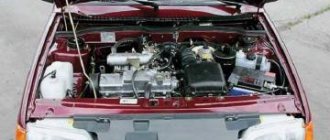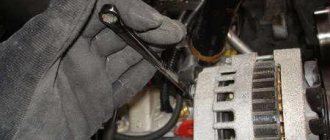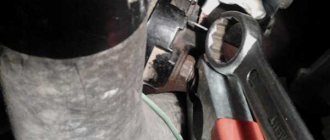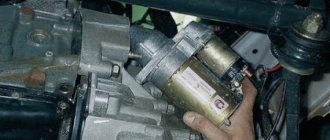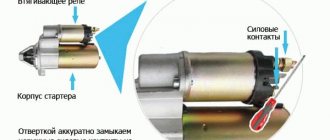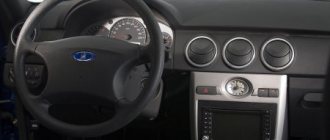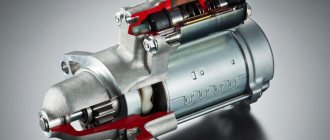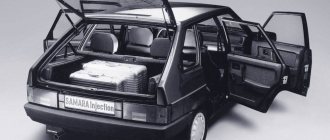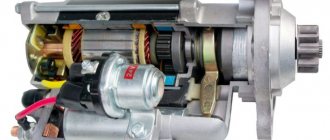January 15, 2015 Lada.Online 322 641 380
To start the engine, you need to ensure that a spark appears at a certain moment to ignite the air-fuel mixture in the cylinders. Problems with starting the engine occur if one or more elements of the system malfunction. The table lists possible reasons why the Priora does not start.
What to do if the Lada Priora does not start and does not turn the starter
A car is often included in the list of the most necessary items for a comfortable life, and the inability to use it is perceived by many as a serious deprivation. However, all equipment breaks down sooner or later, and a car, for example, may stop starting. Here, the first thing that is required is to find the cause and fix the problem as quickly as possible. The trouble is that owners often have no idea where to start the work. In this article we will tell you why the Priora specifically does not start and why its starter does not turn.
Weak starter
If the Lada Priora does not start, then the possible reason is that the element is too weak. It simply cannot crank the crankshaft to the minimum 300 rpm. In this case, the required compression is not provided. Even if the starter manages to spin the crankshaft to the required speed, the engine still does not start, since all the battery energy is taken for spinning. It is not enough to operate the injectors and the ignition system.
general information
The starter is the key mechanism that ensures the starting of any vehicle equipped with an internal combustion engine.
In fact, it is an electric motor equipped with a special gear with a transmission mechanism. When activated, the part engages with the flywheel and rotates it, thereby providing a start to the gasoline engine. The control element is a solenoid relay. It supplies voltage to the unit’s motor and regulates the stroke of the bendix. When the driver turns the key in the ignition, an electrical circuit is activated. Current flows to the relay magnet, which attracts the armature, which closes the contact group, which causes the starter to spin.
The force it creates is transferred to the flywheel, the crankshaft begins to rotate and the car engine starts. After this, the driver releases the key, the power is turned off, and the relay opens the contacts, after which the starter stops working.
Troubleshooting Starter Problems
The starter is an important element of the engine starting system. Its task is to ensure vigorous rotation of the crankshaft, which transmits translational motion to the piston group, creating the necessary degree of compression in the combustion chamber and removing exhaust gases.
Basic starter malfunctions:
- short circuit in the traction relay winding;
- oxidation of wire tips;
- bendix jammed;
- break or short circuit in the starter winding;
- worn or damaged starter brushes.
If the device fails in the field, when it is not possible to contact a service station, you can jump start the car. For this you will need an assistant. Having accelerated the car with the ignition on, you need to quickly engage second gear and release the clutch: the car starts to twitch, but after two or three jerks it starts. This is the most popular method of starting the engine when the battery is dead or the starter is faulty, but it can only be used on vehicles with a manual transmission.
Repairing the Lada Priora starter can be done by removing it from the engine: this makes it easier to carry out preventive maintenance, unlock the bendex, and replace brushes. If a winding break occurs, you need to install a new starter assembly, and it is advisable to do this on a cold engine.
If Priora does not want to start
When the car does not start and its starter, accordingly, does not turn, then most likely the culprit is the battery. This is indicated by the following additional symptoms:
- the solenoid relay clicks;
- The instrument lights on the panel go out.
The easiest way to test the battery is to turn on the headlights. If they burn weakly, you will have to charge the battery.
When the battery appears to be in good condition, but the car still does not start, feel the cables connected to it. If the ends screwed to the terminals (or the starter itself) are warm, then there is poor contact or oxidation. All this creates increased resistance, stealing battery power.
- unscrew the wires;
- clean the battery leads and terminals themselves;
- return the cables to their place;
- Make sure that the ground on the body and the positive on the starter are securely fastened.
Next, check if there is voltage at the ignition switch. This is done like this:
- disconnect the connector of the cable going from it to the traction relay;
- turn the key to the engine start position;
- measure the voltage at the connector.
When nothing suspicious is found here, go to the Priora traction relay. Power it directly from the battery. It is convenient to use cigarette lighter wires for this.
Connect the minus to the starter housing, and the plus to the corresponding relay terminal. Ideally, the mechanism should start working, that is, its shaft will begin to rotate and the gear will move forward.
If this does not happen, try changing the control element itself and if the result is negative, take on the starter electric motor:
- Leave the negative wire from the battery on the body;
- plus, hook it to the lower contact of the solenoid relay.
A working engine will start working. If not, then look at its brushes. They can wear out and need to be replaced regularly.
The lack of a positive result allows us to draw one conclusion - the main reason why the Priora does not want to start is a bad starter. The unit is not repaired, but replaced with a new one.
How to fix problems after washing
For each situation there is a solution. If the driver used the services of a car wash, then you need to check whether water got inside the car
It is especially important to do this if the motorist has washed the engine and the car does not start. When carrying out a regular washing of the surface of the car, it is necessary to open the hood at the end of the work and check for the presence of water near the engine and other important elements
The battery, terminals, spark plugs and all wiring must be thoroughly wiped down so that moisture does not increase the amount of current drawn or drain the battery. If visiting the car wash was a fairly frequent procedure, then you need to check for gray deposits on the battery terminals. It prevents normal contact and, as a result, normal operation of the battery.
It is best to wipe the area under the hood with a soft cloth or sponge, as they absorb water best. The sponge allows you to remove moisture even in the most difficult to reach places. After wiping off the water, the car should start normally.
If the car does not start after washing the engine, this will require a more thorough inspection. First you need to inspect the spark plugs, since wet spark plugs do not produce a spark. Water under the distributor cap will also prevent the car from starting. It will need to be unscrewed and wiped completely.
Water can also accumulate in the spark plug wells, so it is better to blow them out. All wires must be inspected and, if necessary, thoroughly wiped to prevent short circuits. All this must be done before starting the engine for the first time after washing. Then you can prevent a number of problems and prevent serious breakdowns.
There are situations when, after water gets in, the car’s electronics behave strangely. This manifests itself in the fact that the car does not start when the driver has washed the engine, and the immobilizer is on. An immobilizer is an anti-theft device that, using a special program, can stop connecting electrical circuits in the most important areas.
You can avoid a flooded engine when you do not use a high-pressure car wash. It is these devices that drive water inside the motor, which prevents its normal operation. It is best to wash the engine by hand, the old-fashioned way, and clean hard-to-reach areas with a brush. This will take more time, but will not cause problems with starting the car.
Lada won't start when cold
Check how fast the crankshaft spins on your Priora. Too low a speed indicates:
- dead battery;
- hardening of the lubricant.
The absence of any reaction from the motor suggests that the problem lies in:
- fuel system - sometimes condensate freezes there;
- a sensor that monitors the temperature of the antifreeze;
- loss of tightness of nozzles;
- weak compression in the cylinders;
- failure in the on-board computer.
If the car starts unstably in winter, then perhaps there is low-quality gasoline in the Priora tank or a lot of condensate has accumulated. It would also be a good idea to look at the spark plugs and the cables leading to them from the distributor, the ignition unit itself, and the sensor that monitors the oxygen level.
Ignition
Ignition problems, as experts say, occur quite often in Priora. It is relatively easy to verify the functionality of this system. This is done by checking for the presence of a spark on the spark plugs. If it is not there, then it is possible that:
- the ignition unit is broken;
- The crankshaft and distributor sensors do not work correctly.
To conduct a full diagnosis, you will need to visit a car repair shop. Here, special equipment is used, through which it is easy to determine which element is causing the problem.
If there is no spark at the spark plugs, we can say with a high degree of confidence that they have failed:
- ignition unit;
- his reel.
Sometimes it won't start with the key only directly through the starter. VAZ 2110
Hello, sometimes I can’t start the car with the key, turning the key there is no reaction, then I take a screwdriver and close the contacts directly on the starter and it starts with a bang, the electricians shrug their shoulders, what could be wrong?
jiejiik: electricians shrug their shoulders
No one likes to look for periodic faults, so they shrug their shoulders.
The reason may be; both in the ignition switch, and in the mounting block, and in the blocking contacts of the signaling system, and in any “nozzle” (poor contact) along the road.
jiejiik: Hello, sometimes I can’t start the car with the key, turning the key there is no reaction, then I take a screwdriver and close the contacts directly on the starter, it starts with a bang, the electricians shrug, what could it be? #
This topic also began to cloud my mind. I turn the ignition key and wait. It happens that after 5 seconds it will grab and start. In most cases, the starter contact is to blame.
The plate turns sour and makes poor contact. Sometimes it doesn’t break through, especially when it’s cold. I'm waiting for dry weather (or when it stops gripping completely) so I can get into this mud and clean the wiring.
Source
Some tips
Did your car fail? Car owners complain that their car has difficulty starting when hot. If in the morning the vehicle can be started well, then after a short drive and turning off the engine, you will need to turn the starter while pressing the gas to start the engine. At the same time, it starts to smell like gasoline and stops for a few seconds.
Auto mechanics recommend solving this problem by replacing the following parts:
- spark plugs,
- fuel and air filters,
- installing a thick textolite gasket under the fuel pump,
- injectors,
- ignition module,
- water temperature sensor.
If the car has difficulty starting when cold, then the problem may be due to the use of low-quality gasoline. In this case, you must refuel only at trusted gas stations. Another reason why the Priora starts worse in cold weather is that the battery loses part of its capacity. The starter turns harder. The oil loses its viscosity and becomes thick. At low temperatures, it is recommended to fill in synthetics.
As a rule, to start the car, 1-2 rotations of the starter armature shaft are necessary. A vehicle in good condition will not have difficulty starting hot or cold. To do this, auto mechanics advise Lada Priora owners to adhere to the following recommendations:
| Advice | Explanation |
| Pour a lot of gasoline into the tank. | Otherwise, condensation will form. Water will not be able to get into the fuel. |
| Before starting your car in cold weather, you need to turn on the high beams for a couple of seconds. | This step will allow, in cold weather, to restore part of the vehicle’s capacity due to the processes occurring in the vehicle. |
| If there is an injector, then you will need to turn on the ignition and wait. The carburetor must be pumped with gasoline manually. | During this time, normal pressure will be created in the fuel system. In any case, do not overdo it, as the spark plugs will flood. |
| You can add a little gasoline to the oil before leaving home. | The car will cool down, and the oil will not lose its viscosity. When the car starts, the gasoline evaporates. The main thing is not to overfill the fuel. |
Check all components of the ignition system If these recommendations do not help and the engine does not start, then you need to check the ignition system.
Why does the starter not respond to turning the ignition key?
After turning on the ignition, power from the battery is supplied to the on-board electrical systems and the computer (if equipped). If there is an immobilizer (standard or an installed security system), this occurs only after the tag is recognized. When the key is turned to the start position or the start button is pressed, the contacts of the solenoid relay are closed, resulting in power being supplied directly to the starter. At the same time, the starter overrunning clutch (Bendix) engages with the flywheel crown, setting it in motion and ensuring the engine starts. Often, switching is carried out through an additional starter control relay, which removes the load from the lock.
Ignition switching circuit
If a problem arises at any of the above stages, the car will not start: you turn the ignition key and the starter is silent. As a rule, the reasons for this behavior lie in:
- ignition switch contact group;
- alarm and immobilizer;
- control relay;
- wiring from the control relay to the starter;
- starter solenoid relay.
More information about why the starter does not work with the ignition key can be found in the table.
The starter does not work from the ignition key: reasons
| Problem | Cause of malfunction |
| Starter motor faulty | The electric motor fails due to overheating, short circuits in the windings, wear of the brush assembly, and jamming of the gearbox. |
| The circuit from the ignition switch to the starter solenoid relay is faulty | Wiring break or short circuit. Often occurs after repairs, installation of additional equipment, or as a result of mechanical wear during long-term use. |
| Damage to the ignition switch (deformation of the cylinder) | Deformation due to overheating, which in turn occurs due to poor contact. Damage is also possible due to the mistaken use of an inappropriate key. |
| Electrical malfunction of the ignition switch contact group | The layer of oxides formed on the contacts prevents the flow of current. Also, the contacts may move away due to deformation of the rotary sleeve on which the mating parts are attached. |
| Start blocking by installed alarm | A voltage surge in the on-board network or loss of power (disconnection of a terminal or discharge), failure of a transistor or microrelay responsible for turning on the start line in the base unit of the security system. |
| Immobilizer malfunction/decoding | Voltage drops and sudden loss of power (battery discharged or terminal removed), software failure, failure of microelements. If the immobilizer does not recognize the mark, the starter does not turn after turning the ignition key, and the immobilizer symbol usually lights up or flashes on the indicator panel - an image of a car with a key or lock. |
| Failure of the solenoid relay | Burnout or short circuit of the winding as a result of overheating due to the flow of increased current or being under load for an extended period. The root of all problems is usually oxidation of the internal and external contacts of the solenoid relay. |
| The limit switch for the automatic transmission selector position, the brake pedal for an automatic transmission or the clutch for a manual transmission is faulty | Sensors fail due to mechanical wear, and their wires and terminals can oxidize or fray. Because of this, the ECU does not allow the starter to start. |
| Starter relay failure | If the starter control relay is stuck or shorted, it cannot supply power to the control terminal of the solenoid relay. |
| Poor “+” contact from the battery on the starter | The power contact terminal oxidizes under the influence of moisture and heat. The nut that holds it to the starter stud can come loose due to vibrations. |
| Poor ground contact at the battery terminal, car body or engine | Due to oxidation, the contact of the ground wire deteriorates; the same thing happens when its nut is unscrewed under the influence of vibration. In this case, the passing current may be enough to turn on the on-board network and the ECU, but not enough to drive the starter electric motor. |
Fuel system
Problems here also very often do not start in the cold. First of all, check whether the required pressure is required directly in the fuel rail. A pressure gauge is connected to the coupling mounted on it. If after turning on the ignition it does not rise, then most likely there is a malfunction:
- gasoline pump;
- a relay that controls its operation;
- blown fuses.
Next, make sure that the suction line in the fuel tank is clogged and that fuel is flowing through all lines.
It's worth checking to see if the spark plugs are wet. This happens quite often after the power plant overheats. In this case, they are removed from the sockets and tested. Often simply wiping them dry is sufficient.
To start an engine, two main components must be present: the air-fuel mixture in the combustion chamber and a spark from the spark plug. The first is the responsibility of the car’s fuel system, which supplies gasoline from the tank to the unit that prepares the combustible mixture. The presence of a spark is ensured by the ECU. It delivers a powerful electrical discharge to the spark plug in the final cycle of compression of the air-fuel mixture in the combustion chamber. As a result, the crankshaft and the associated piston group rotate. A failure in the operation of any component will cause difficulty in starting the Priora engine or make it impossible.
What to do if the starter does not turn the engine from the ignition switch
If when you turn the ignition key the car does not start, and nothing happens at all, in some cases you can correct the situation by supplying power to the starter, bypassing the lock. This solution is suitable for cases where the electric motor itself and the solenoid relay are in good working order. In this case, you need to proceed according to the following algorithm:
Control wire terminal
- Turn on neutral gear and ignition.
- Find two terminals on the starter: a thick power wire from the battery positive and a thin control wire from the control relay.
- Using a metal object (screwdriver, key, wire), close the power and control contacts.
- After the starter operates and the engine starts, immediately open the contacts.
An alternative to the same method is to supply power to the starter control terminal directly from the positive terminal of the battery. This can be done using any insulated wire, for example from a cigarette lighter wire kit.
The lack of response of the starter to direct power supply indicates its breakdown, failure of the electric motor or the solenoid relay. To diagnose the starter, you need to disassemble the starting unit, inspect the brush assembly, armature and stator windings. This is not easy to do in the field and without a multimeter, so you need to push the car and get to the garage or service station.
When the starter turns directly, but not from the key, then the starter itself is fully operational, and the problem lies in the electrical circuit from the key to the starter. To determine the location of the breakdown, you need to follow the instructions given below.
How to look for the reason if the car does not respond to the ignition key - instructions:
How to start the engine by jumping the starter directly: video
- The characteristic light click of the triggered starter relay when turning the key to the “start” position in most cases indicates the serviceability of the ignition switch and its contact group. Next, you need to look for the problem in the engine compartment.
- To check the solenoid relay, you need to connect a wire to its control terminal (a terminal with a thin wire) directly to the “+” terminal of the battery. A working relay should click and push the bendix towards the flywheel, and also start the starter rotating. The presence of a clicking sound without cranking the starter is a sign of poor contact of the power wire or a malfunction of the starter motor itself.
- You can check the serviceability of the motor by directly closing its retractor power contacts - they are made in the form of large diameter pins. If after this the starter spins, the retractor winding is faulty or it is jammed.
- For more detailed diagnostics, the solenoid relay must be removed from the starter and disassembled. First of all, look at the contact “nickels”, which can oxidize and burn. If there are traces of these processes, you need to clean the contacts, assemble the relay, return it to its place and check the operation of the starter. If everything is clean, you need to check the solenoid winding, for example, by ringing it with a tester for a short or open circuit.
Hot
So, the car drove some distance. In the morning it started up with a half-turn, and forward. But then some distance was covered, a stop was made, the key was turned to “start” and... Several painful revolutions, and only then the engine started working. What's happened? As a rule, there can be many reasons. Conventionally, they can be divided into groups:
- The fuel system is acting up.
- Errors or breakdowns of sensors or actuators of the control system.
- Engine wear.
The first step is to check the presence of fuel in the injector frame. Gasoline supply is the most likely cause of problems. To do this, you need to open the hood and remove the decorative trim from the engine. The intake manifold runs between the engine and the Priora radiator. Below it is a fuel frame. At the end there is a special bypass valve, closed with a plastic cap. You need to unscrew it and press on the core. A strong release of fuel should occur.
When connecting this device, you need to turn on the ignition without trying to start it. The pressure must be at least 2.6. There is another option. Not so reliable, but quite usable. Perform the download several times before starting if the Priora is difficult to start. That is, without turning on the starter, wait until the fuel pump turns off, turn off the ignition and turn it on again without the starter. Do this several times. And then turn the engine. If starting improves, it means there was not enough pressure and you need to check the filters and fuel pump.
And another reason related to the fuel system is the banal clogging of the injectors, which gives the effect of poor starting to the same extent. But this is just a specialist checking the entire fuel frame at a special stand.
Electronic part of the check
Here it is worth clarifying immediately. There can be no talk of any complete determination of the cause of a poor startup without computer diagnostics. Although several positions can be checked. The easiest way is to check the performance of the Priora cylinders. To do this, you need to remove the decorative cover, start the engine and leave it at idle. Let it work a little and try to remove the connectors from the ignition modules one by one.
This requires good hearing and attentiveness. It is necessary to clearly determine which of the cylinders, when switched off, the operating rhythm changes the least.
Next, having determined the worst-performing “boiler”, perform the following actions:
- Using a 10 mm wrench, unscrew the bolts securing the modules from the “bad” and any other cylinder.
- Swap them and secure them.
- Repeat the procedure with listening. If the signs of a “bad” start move to another “boiler,” then the ignition module is to blame. And replace it.
- If no changes occur, then swap the spark plugs.
- Repeat the procedure again. If there is no change, then either the injector or wear in the cylinder is to blame.
In addition, one of the main sensors that controls the launch of the Priora is the mass air flow sensor (MAF).
Crankshaft position sensor
This is the main device that gives the start signal. If it fails, the car simply will not start. But there is a small nuance. If the damper is dirty, or a lot of dirt has adhered to the sensor itself, a “bad start” effect may occur. But it's easy enough to check. This device is installed on the oil pump housing to the left of the timing pulley. If it starts poorly, just visually examine its condition and clean it if necessary.
Poor starting due to engine wear
This is quite a rare occurrence. In general, VAZ 2170 Priora engines are quite durable with proper care. But as they say, even an old woman can get screwed. In this case, engine wear is determined by dark exhaust from the pipe and increased oil consumption. Well, in general, here you need specialist advice. The motor must be inspected by a mechanic. And do a compression test.
Frequent malfunctions on popular cars
In most cases, the starter does not turn when the ignition key is turned due to oxidation and mechanical damage to the wiring. If there is poor contact with the “+” terminal of the battery, the control relay or ground, the starter does not receive enough current to crank the engine . Therefore, first of all, you need to look at the contacts in the engine compartment and check for voltage at the terminals with a tester. The most common malfunctions of specific car models, due to which the starter does not respond to the ignition key in the table.
| Why does the starter not work from the ignition key on popular car models? | |
| Auto | Weakness |
| VAZ 2110, 2111, 2112 | Wires of the central locking and ignition switch, which melt due to power surges. |
| VAZ 2108, 2109, 21099, 2113, 2114, 2115 (Lada Samara) | Oxidizing contacts of the control relay located in the engine compartment above the VUT, as well as the wiring extending from it. |
| VAZ 2101, 2102, 2103, 2104, 2105, 2106, 2107 (Classic) | The contact “nickels” of the solenoid relay often burn or oxidize. The contact group of the ignition switch fails. On later models, for example, 2107, problems with the control relay are similar to Samara (see above). |
| Niva | On old Nivas (before 21213), the ignition switch contacts burn and oxidize. On newer ones (after 21214), the starter control relay, located under the hood near the brake fluid reservoir, often fails. There is a drainage tube located nearby that drains water from under the glass, moisture from which gets onto the relay, which leads to oxidation of its contacts. |
| Lada Priora | Immobilizer problems due to which it does not see the key. |
| Lada Kalina, Lada Granta | Failure of the immobilizer, blocking the start, malfunctions in the contact group of the ignition switch and failure of the additional starter relay K3 in the fuse block. |
| UAZ | Malfunction of the 5-pin starter control relay and solenoid relay. |
| Gazelle | Poor contact of wires and failure of the starter relay. |
| Peugeot 307 | Solenoid relay fuse F8 blows, poor ground contact. |
| Kia Sid | The limit switch of the automatic transmission selector, which determines the P and N positions, is faulty. There may be poor contact at the starter terminals or at the point where the ground wire is attached to the body. |
Sources of the problem
Communities Lada Priora Lada Priora Club Blog what is affected by the clutch release switch The reasons why the Lada Priora does not start may be a malfunction in the fuel system:
- clogged fuel filters;
- failure of the fuel pump;
- lack of gasoline in the tank;
- clogged injectors;
- condensate freezing in the fuel line.
Having certain skills, every car enthusiast can fix these faults with his own hands. First you should check whether gasoline is supplied to the ramp with injectors. To do this, you need to disconnect the fuel hose from the rail and connect the pressure gauge. Then ask an assistant to start the engine. When the fuel pump is running, the pressure in the fuel line should be 2.7 atmospheres. If the pressure is lower than specified, you should look for the cause in the fuel filters.
A complete lack of pressure when a voltage of 12 V is applied means that the fuel pump has failed. To fix the problem, you need to replace the fine filter, wash or change the fuel pump filter, or replace its electric motor.
If the pressure in the fuel line is normal, the cause should be sought in the injector rail. You need to remove it from the engine, wash it with a special liquid and blow out all the holes with compressed air. To prevent condensate freezing from causing a lack of fuel supply, repair work should be carried out in a warm room.
List of possible malfunctions related to the operation of electrical equipment:
- Insufficient battery charge.
- Battery terminals are oxidized.
- The starter does not work.
- The traction relay is faulty.
- The timing belt is broken.
- Malfunction of the electronic control unit.
- The valve timing is disrupted.
- Severe contamination of high-voltage wires or lack of contact.
- Pulse transformers are faulty.
- The fuses responsible for the operation of the ignition system and starter have blown.
- Spark plugs are flooded or faulty.
- Burnt ignition switch terminals.
- The immobilizer is faulty.
Before you start looking for these problems, you need to make sure that the contacts and connections of all wires are reliable, that there is no oxidation, breaks or abrasions.
Answers to frequently asked questions
How can you tell if the starter relay is not working?
To determine whether the starter relay is working, apply power from the positive terminal of the battery directly to the control contact of the relay. After this, a click should sound; if it is faulty, there will be no sounds.
How to check whether the starter is working or not?
To check the serviceability of the starter itself, you need to apply current to it directly by connecting the power wires of the retractor relay (thick wire from the battery) and the electric motor (stud with a thick wire from the retractor to the starter). A working starter should start moving.
What to do if the starter does not work after turning the ignition key?
First, make sure there is voltage at the battery terminals. If you don’t have a tester, this can be done using a 12 V lamp. Then try to apply voltage directly to the starter: use a screwdriver to close the pin to which the wire from the battery goes and the control contact located nearby. If there is no reaction, check the quality of the contacts of the terminals on the battery, the ground contacts (with the body and the engine) and the contacts of the starter itself by cleaning and tightening the terminals. If the battery is discharged or the starter is faulty, you need to start the car with a pusher (manual transmission) or tow it to the repair site.
Pay attention to electrical wiring
The correct position and connection of wires in the system are also important. Often the wire “comes off”, which causes ignition problems. The fix is simple: you need to connect it back and, in general, check that all connections are correct and that they correspond to the electrical circuit of the car.
The ignition system itself, either as a whole or its individual elements, is also subject to breakdown; it must be checked using a tester. Another common cause of problems with starting the power unit is irregularities in the fuel supply, the culprits of which may be the relay and fuse of the fuel pump. This is diagnosed by the absence of sounds from the pump, and the correct solution is to replace it.
Problems launching Priora: checking system operation
If, after performing basic research, the car starter turns and the Priora does not start, then you should look for the reasons in other control systems. For example, malfunctioning ECU or coolant sensor may make it impossible to start the power unit.
Such problems are solved at a service station, and the driver will have to call a tow truck to send the car to specialists. This solution is also acceptable in the case when the crankshaft position sensor has stopped working normally.
A broken timing belt or shearing of its teeth will result in expensive repairs, so the element should be replaced as soon as possible. Problems with the crankshaft may be associated with individual components of the cylinder-piston group, the generator wedge or the coolant pump.
If the engine refuses to work in extreme cold conditions, the engine oil may simply have frozen. Correct operation of the car is ensured only if the substance used is completely changed to that recommended by the manufacturer.
A dirty fuel filter or damaged fuel line will also affect engine performance. In this case, the starter will work normally, but the engine will not be able to start.
First of all, you will need to clean the filter, because in some cases the pressure in the rail will be insufficient to start the unit. If the reason is damage to the fuel line or the filter itself, then they will need to be completely replaced.
Another reason could be a blown fuse or relay of the control system or idle speed regulator. In the first case, you will need to study the fuse and, if necessary, install a new one. If, after starting, the engine stalls after releasing the gas pedal, then the idle speed sensor needs to be replaced. All procedures are usually carried out at a service station.
In any of the situations described, the Priora must be repaired immediately. Even if the launch was successful after several attempts, similar problems should not be ruled out in the future.
Main reasons
So, a man finds himself in an unpleasant situation when the starter of his Priora spins, but the engine does not start. There could be a whole bunch of reasons for this. It’s worth talking about them in more detail.
- 1. The fuse has blown
. In this case, you will need to check its integrity. To do this, you can use a special indicator in the form of a screwdriver or a tester. If these tools are not at hand, you will have to wait for help from passing drivers; - 2. The terminals
on the battery have oxidized or it is simply discharged. This seemingly typical car malfunction can serve as another reason. If the battery does not have enough voltage, it will be able to turn the starter, but there will not be enough charge to power the engine. It is worth checking the device to rule out this possibility; - 3. Defective ignition switch;
- 4. Corrosion. It can appear on any electrical part of the Priora. First of all, it is worth checking the starter itself, because it is always open to the flow of moist air, and this is the main cause of oxidation;
- 5. The ignition coil is faulty. This can also be checked by calling. For these purposes you will need a tester. If this part malfunctions, it must be replaced.
- 6. Accumulation of condensate
under the hood of the Priora; - 7. Fuel supply system problems
. This is very common in this kind of trouble. There are a whole bunch of devices that are responsible for the smooth operation of the system. It is not always possible to fix the problem yourself, so it is better to turn to professionals; - 8. Candles are flooded. And this problem can arise for every car enthusiast. In this case, it is imperative to use a spark plug tool to remove the spark plugs and then check their functionality. Sometimes just wiping them is enough, but sometimes they may need to be replaced. It is better to carry them in the trunk for this occasion;
- 9. Engine overheating
.
This is another nuisance that can lead to the car's operation being suspended. There could be many reasons for this. For example, there may simply be a leak of coolant from the expansion tank. There are many tubes coming out of it, so each of them may be faulty. Unstable operation of the thermostat, which is responsible for starting the engine, can also lead to the inability to start it. There is only one piece of advice here
- immediate replacement of the unit. There is so-called internal overheating, which is much worse than external overheating. While all sensors will definitely report the second option, the second option is practically indeterminable. You need to immediately contact the service for help.
Generator
When this element is working properly, it produces a voltage within 14 volts, provided that the engine is idling and there is no load on the vehicle's electrical system.
In this case, the first start leads to an increase in voltage by 2 volts. Later, stabilization occurs to standard levels. They are also affected by:
- battery condition;
- load;
- air temperature.
Problems with the generator are very often the reason for the inability to start the engine. In cold weather, the voltage can fluctuate from minimum values (12.9) to maximum values of 14.8 volts.
The 16-valve Priora in such a situation needs to have its generator inspected. It is easy to verify its functionality by connecting the power directly, bypassing the regulator. If it is possible to detect excess voltage, the latter relay needs to be replaced.
Elimination of breakdowns of the anti-theft system
The principle of operation of the immobilizer
In the body of the original ignition key there is a transponder chip 3, which contains a complex electronic code. When the driver inserts the key into the ignition, the immobilizer is activated and the electromagnetic waves 2 of the electromagnetic coil 1 begin to read the encoded code. If the codes in the memory of both the immobilizer electronic unit and the transponder match, the engine starts; if there is an error during reading, the engine will not be able to start.
You will need a PIN code to reinstall the software. If it is not there, you will have to buy a new ECU.
The system may not respond to the key if the reading coil is damaged: in this case, the lock assembly with it will have to be replaced. To avoid causing problems with the immobilizer, you should not try to start the engine in severe frost or if the battery is discharged. It is not recommended to place keys near sources of strong electromagnetic waves (for example, a microwave oven). You cannot keep keys from different cars in one bunch, or remove the battery terminal while the ignition is on.
All problems associated with starting the engine can be resolved using the instructions described. A car is a complex mechanical and electronic system that requires careful handling and following certain rules during operation. Otherwise, a malfunction may occur at the most inopportune moment.
Content
In fact, there are many reasons why the Priora engine does not start. The most common of them are discussed in the article below. Such information will undoubtedly be very useful for owners with little experience.
Repair and replacement of the engine start switch
The ignition switch of the Lada Priora is an electromechanical device consisting of a contact group and electrical communications. This engine starting system component wears out when the tracks are switched on and off repeatedly. When they are mechanically damaged, current conductivity deteriorates, resistance and temperature in the contact area increase, which leads to their burning. Another reason for ignition switch failure is the breakdown of plastic parts.
Malfunctions associated with problems with electrical connectors arise due to overload of the contact group caused by the connection of additional high-power devices. Another problem is short circuit. On the latest car models, modified designs are installed that have a more reliable contact group. If these defects are detected, the Priora ignition switch with immobilizer assembly will need to be replaced.
First you need to disconnect the negative battery terminal, then remove the plastic steering column cover, the electrical connector of the main wiring harness and the instrument mode switch. The next step is the most difficult: you need to remove the screws securing the lock to the steering column. They have round tear-off caps that provide an additional degree of security for access to the ignition switch. For this reason, they should be unscrewed carefully, using a special sharp chisel, lightly tapping it with a hammer. It is enough to make one turn of the screw to be able to unscrew it by hand. By unscrewing all four fasteners, you can remove the lock fixing bracket. The final stage is to disconnect the plug of the contact group. After replacement, installation of the removed parts is carried out in the reverse order.
Priora stalls while driving
Often a Priora car may have this type of malfunction when the car stalls while driving. Previously, it was believed that this problem mainly affected domestically produced cars, but it turns out that many foreign cars “suffer” from the same problem.
But, let's talk about the Priora car, the malfunction can manifest itself like this: the car starts up, it accelerates well, but when you remove the gas pedal, the revolutions begin to fluctuate, the engine rattles, that is, its speed level changes all the time, although the tachometer arrow should point to 1000 revolutions. After a while the car stalls. If you start it, everything will repeat itself. What to do in this case? Let's try to break down the main points so we can easily fix the problem.
Battery
As we know, when you turn the key, the starter
, which begins
to rotate
the crankshaft. If this unit does not respond to the described action, they immediately climb to the battery. It is well known that if the voltage drops to 10 volts or below, the starter, by and large, will not be able to work. But it is worth realizing that low performance does not necessarily indicate battery dilemmas. Quite often, unsuccessful attempts to start the engine lead to this. To avoid battery drain, you should not repeat them more than 2-3 times. The problem also appears due to improper operation of the generator.
As a result, the battery will need to be fully charged. Only then can you try to start again. In order not to waste time, it is best to replace the battery with a previously serviceable one.
You can ask permission from someone you know to connect to their battery directly. If the problem is solely in the battery, then the engine will start without much difficulty.
